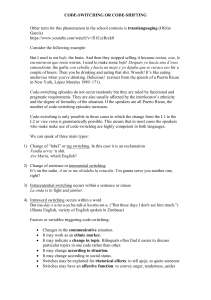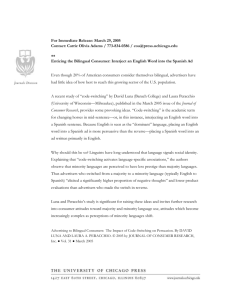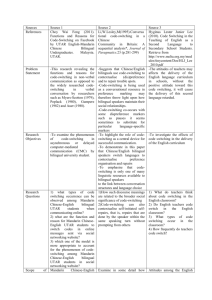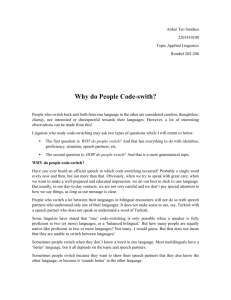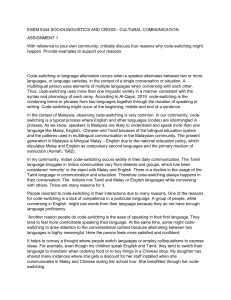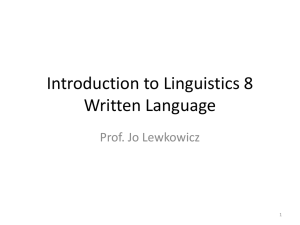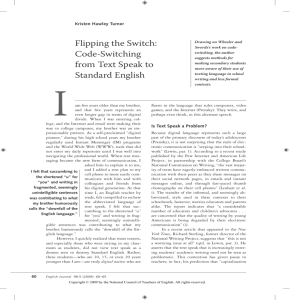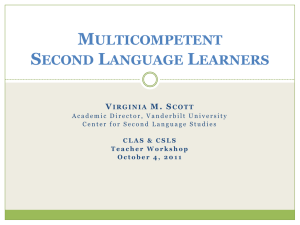2. intra-sentential switching
advertisement
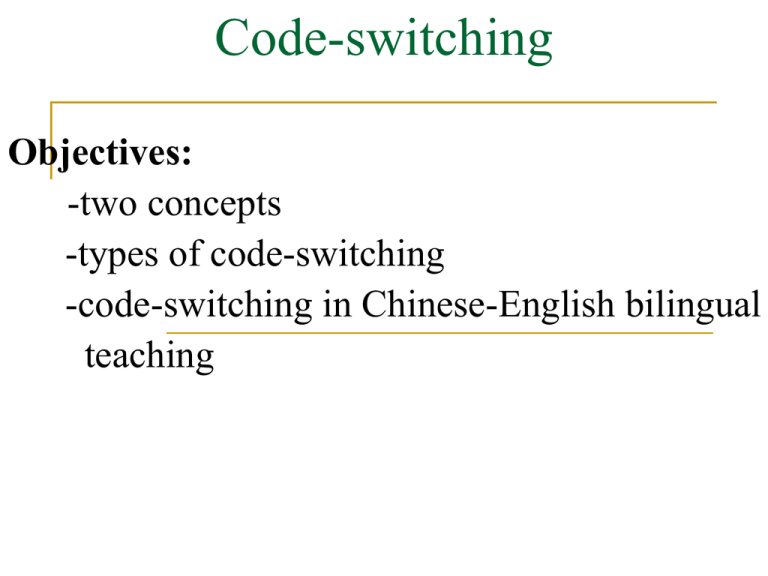
Code-switching Objectives: -two concepts -types of code-switching -code-switching in Chinese-English bilingual teaching I. Two concepts 1. code -a set of words, signs, etc. that convey information (代码) -a language or a variety of language (语码) 2. code-switching -switching from one language to another or -using more than one language/variety to another in conversation II. Types of code-switching 1. intra-word switching a change or movement within a word eg. shop pa (English + Panjabi plural ending) kuenjoy (Swahili prefix ku + English ) (三本)书s 2. intra-sentential switching switching within a clause or sentence eg. 玫瑰 flower 乱 speak 今天是Christmas Day. That happened just at the moment, 当 他进来的时候. 3. tag-switching a kind of intra-sentential switching, in which a tag question of one language is inserted into an utterance of another eg. It’s a nice day, hana? I’m energetic today, 是吗? 4. inter-sentential switching a change or movement which takes place at a clause or sentence boundary, where each sentence or clause is in one language or the other eg. 这些是月饼,and those are sandwiches. I take the great honor to make known to all the plan for The English Culture Festival. 首届英语 文化节将于2008年12月26日开幕。 III. Reasons for code-switching 1. It is a shortcut to communication. eg. What do you think of the idea shǎo zhēteng? 2. It avoids awkward directness. eg. 妈妈,I love you. 我要去toilet, 你去吗? 3. It is clearer and more efficient to explain. eg. 处(chu/chu) 除了 4. It avoids obscurity and saves time. eg. the teaching of The Life of Balsam (a herbaceous plant cultivated for its helmeted flowers, which are typically pink or purple) 5. It is just for fun. eg. 乱speak! Worker们, lets go. 外面下雨了,你拿umbrella没有? 她怎么就disappear了呢? iV. Case study of code-switching in the bilingual teaching of our country 1. general information of the sample case -35-minute math class by Jin Lan -The Changchun Shuxun Primary School - solve problems 2. The types which occurred in the class eg. Very简单 intra-sentential eg. 综合算式呢?Who can tell me? inter-sentential 3. The reasons for the teacher to switch in that class 1) from English to Chinese -repeating casually eg. “Can you? 能吗?” eg. “Which one do you like best? 更喜欢哪一种?” -guaranteeing better understanding eg. “Who can tell me how do you range it?, 怎样组成的?”. eg. “Very good. 那么, 这是分步算式,谁能告诉老 师综合算式是什么呢?” 2) from Chinese to English Organizing teaching eg. “Very good.” “Stop here.” “Are you clear?” “Yes or no.” “You, please.” “Who can answer the question?” “那么,这是分步算式,谁能告诉老师综合算式是 什么呢?OK, the boy, you, please.” “如果按照你们的想法,乘法口诀,或者按照老师 的从小到大,which one is better?” Achieving the target language objective the main math words: question range circle rectangle method calculate divided multiply problem sticker equally main math expressions: ·question one(问题1) ·method two(方法2) ·math problem ·divide…equally into… ·How many…in all? ·Six multiply by eight is forty-eight. ·Forty-eight rectangles in all divided by eight is six. 4. the students’ code-switching and learning effect - whether the students could switch to the target language and follow the teacher - whether they learned effectively with both the subject objective and the target language objective to be achieved Discourse 1 (sentences 23-26) T: What is this? Ss: 机器人。 T: Robot. Ss: Robot. Discourse 2 (sentences 46-48) S: 用上面的材料能够摆多少个sun? T: Together. Ss: 用上面的材料能够摆多少个sun? Discourse 3 (sentences 66-68) T: 好了,你来说说自己的想法。 S: 有一个机器人有one circle and six rectangle。 S: 不够就向下面的机器人借two rectangle。 Discourse 4 (sentences 295-296) T: Divide twelve candies equally into three groups. S: Twelve divide by four is three, 是把12块糖果平均分 给4个小朋友,每个小朋友3个。 Discourse 5 (sentences 92-94) S: 用6乘以8等于48个。Forty-eight divided by eight is six. S: 再用forty-eight divided by eight is six。 S: 48除以8等于6。 Conclusion: Only bilingual students can understand a bilingual teacher, but monolingual students can never sit in a bilingual classroom to listen to a bilingual class. Only bilingual students can switch (especially from their mother tongue to the target language) and think and express themselves bilingually (especially in the target language). Students in China can learn a non-language subject bilingually and effectively!
